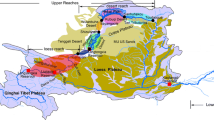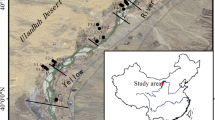Abstract.
The Yellow River flows through an extensive, aeolian Inner Mongolian plateau with a total length of 673 km. Owing to the high erodibility of the Wulanbuhe and Kubuqi deserts and the impacts of its upstream reservoirs, the siltation of the Inner Mongolian Reach of the Yellow River is caused essentially by the aeolian particles larger than 0.1 mm, which are very different from the sediment (>0.05 mm) of the lower Yellow River coming from the loess plateau. During the period 1954–2000, the total accumulated sediment of this area was about 20.1×108 t, the coarse sediment larger than 0.1 mm (AS) about 15.2×108 t, and the fine sediment less than 0.1 mm (FS) about 4.9×108 t. In particular, there was 6.1×108 t AS coming from the Wulanbuhe Desert, and 5.82×108 t AS from the Kubuqi Desert deposited in the river channel of the Inner Mongolian Reach, representing 78.6% of the total coarse sediment larger than 0.1 mm.
Similar content being viewed by others
Author information
Authors and Affiliations
Additional information
Electronic Publication
Rights and permissions
About this article
Cite this article
Ta, W., Yang, G., Qu, J. et al. The effect of the coarse aeolian sand on siltation of the Inner Mongolian Reach of the Yellow River. Env Geol 43, 493–502 (2003). https://doi.org/10.1007/s00254-002-0666-0
Received:
Accepted:
Issue Date:
DOI: https://doi.org/10.1007/s00254-002-0666-0




